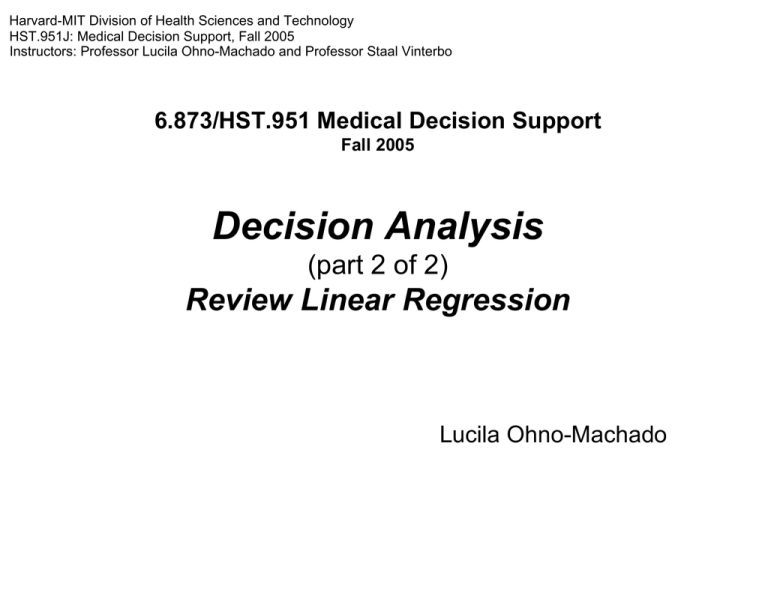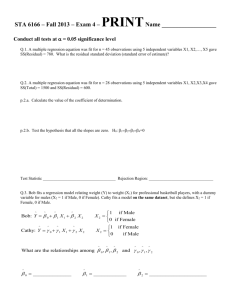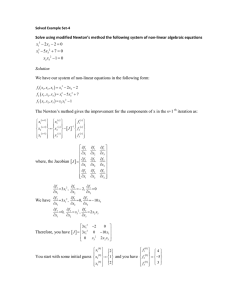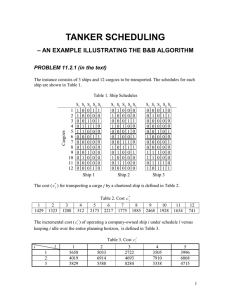Document 13581854
advertisement

Harvard-MIT Division of Health Sciences and Technology HST.951J: Medical Decision Support, Fall 2005 Instructors: Professor Lucila Ohno-Machado and Professor Staal Vinterbo 6.873/HST.951 Medical Decision Support Fall 2005 Decision Analysis (part 2 of 2) Review Linear Regression Lucila Ohno-Machado Outline • • • • • Homework clarification Sensitivity, specificity, prevalence Cost-effectiveness analysis Discounting cost and utilities Review of Linear Regression 2 x 2 table (contingency table) PPD+ PPD- TB 8 2 10 no TB 3 87 90 11 89 100 Prevalence of TB = 10/100 Sensitivity of test = 8/11 Specificity of test = 87/89 threshold normal Disease True Negative (TN) True Positive (TP) FN 0 FP 3mm 10 nl D Sens = TP/TP+FN “nl” TN FN “D” FP TP - + Spec = TN/TN+FP PPV = TP/TP+FP NPV = TN/TN+FN Accuracy = TN +TP “nl” “D” nl Sens = TP/TP+FN 40/50 = .8 Spec = TN/TN+FP 45/50 = .9 PPV = TP/TP+FP 40/45 = .89 NPV = TN/TN+FN 45/55 = .81 Accuracy = TN +TP 85/100 = .85 D “nl” 45 10 “D” 5 40 “nl” “D” Sensitivity = 50/50 = 1 Specificity = 40/50 = 0.8 nl D “nl” 40 0 40 “D” 10 50 60 50 50 threshold disease nl TP TN FP 0.0 0.4 1.0 Sensitivity = 40/50 = .8 Specificity = 45/50 = .9 nl D “nl” 45 10 50 “D” 5 40 50 50 50 disease TP TN FN 0.0 nl threshold FP 0.6 1.0 Sensitivity = 30/50 = .6 Specificity = 1 nl D “nl” 50 20 70 “D” 0 30 30 50 50 threshold nl disease TP TN FN 0.0 0.7 1.0 Cost-effectiveness analysis • Comparison of costs with health effects – Cost per Down case syndrome averted – Cost per year of life saved • Perspectives (society, insurer, patient) • Comparators – Comparison with doing nothing – Comparison with “standard of care” Discounting costs • It is better to spend $10 next year than today (its value will be only $9.52, assuming 5% rate) • Even better to spend it 2 years from now ($9.07) • For cost-effectiveness analysis spanning multiple years, recommended rate is usually 5% • C = C0 + C1/(1-r)1 + C2/(1-r)2 + ... • C0 are costs at time 0 Discounting utilities • Value for full mobility is 10 today (is it only 9.52 next year?) • Should the discount rate be the same as for costs? • If smaller, then it would always be better to wait one more year… Levels of Evidence in Evidence-Based Medicine US Task Force • Level 1: at least 1 randomized controlled trial (RCT) • Level 2-I: controlled trials (CT) • Level 2-II: cohort or case-control study • Level 2-III: multiple time series with or without the intervention • Level 3: expert opinions Examples • Cost per year of life saved, Life years/US$1M • By pass surgery middle-aged man – $11k/year, 93 • CCU for low risk patients – $435k/year, 2 Importance of good stratification • Bypass surgery – Left main disease – One vessel disease 93 12 • CCU for chest pain – 5% risk of MI – 20% risk of MI 2 10 Intro to Modeling Univariate Linear Model • Y is what we want to predict (dependent variable) • X are the predictors (independent variables) • Y=f(X), where f is a linear function y y1 = 1β 0 + x1β1 y2 = 1β 0 + x2 β1 … x Univariate Linear Model β1 is slope β0 is intercept y y1 = 1β 0 + x1 β1 y2 = 1β 0 + x2 β1 … x Multivariate Model • Simple model: structure and parameters • 3 predictors, 4 parameters β • one of the parameters (β0) is a constant y 1 = 1 β 0 + x11 β1 + x12 β 2 + x13 β 3 y 2 = 1 β 0 + x21 β 1 + x22 β 2 + x23β 3 1 ⎤ ⎡ 1 ⎢x x ⎥ ⎢ 11 21 ⎥ ⎢ x 12 x 22 ⎥ ⎢ ⎥ ⎣ x 13 x 23 ⎦ ⎡ β 0 ⎤ ⎢β ⎥ ⎢ 1 ⎥ ⎢ β 2 ⎥ ⎢ ⎥ ⎣ β 3 ⎦ Notation and Terminology • xi is vector of j inputs, covariates, independent variables, or predictors for case i (i.e., what wex know for all cases) 1 • X is matrix of j x n xi column vectors (input data for each case) ⎡ age ⎤ ⎡ 30 ⎤ ⎡ x1 ⎤ ⎢ salt ⎥ = ⎢10 ⎥ = ⎢ x ⎥ ⎢ ⎥ ⎢ ⎥ ⎢ 2⎥ ⎢⎣ smoke ⎥ ⎦ ⎢⎣1 ⎥ ⎦ ⎢ ⎣ x3 ⎥⎦ T ⎡ x11 x21 ⎤ ⎢ x x ⎥ = ⎡ x11 x12 x13 ⎤ ⎢x x x ⎥ ⎢ 12 22 ⎥ 21 22 23 ⎦ ⎣ ⎢ ⎥ ⎣ x13 x23 ⎦ Prediction • yi is scalar: output, dependent variable (i.e., what we want to predict) e.g., mean blood pred ⎡ ⎤ ⎡100⎤ ⎡ y1 ⎤ pat1 pressure = = ⎢ ⎥ ⎢ ⎥ ⎢ ⎥ pred 98 y ⎣ ⎦ pat2 2⎦ ⎣ ⎣ ⎦ • Y is vector of yi Multivariate Linear Model y 1 = 1 β 0 + x11β1 + x12 β 2 + x13β 3 y 2 = 1 β 0 + x21β 1 + x22 β 2 + x23β 3 Y = XTβ, where each xi includes a term for 1 (constant) (x10=1, x20=1, etc.) to be multiplied by the intercept β0 ⎡ y 1 ⎤ ⎢ y ⎥ ⎣ 2 ⎦ ⎡ β 0 ⎤ ⎡ x10 x11 x12 x13 ⎤ ⎢⎢ β1 ⎥⎥ ⎢ x x x x ⎥ ⎢β2 ⎥ ⎣ 20 21 22 23 ⎦ ⎢ ⎥ ⎣ β 3 ⎦ Regression and Classification Regression: continuous outcome • E.g., blood pressure Y = f(X) Classification: categorical outcome • E.g., death (binary) G = Gˆ ( X ) Loss function • Y and X random variables • f(x) is the model • L(Y,f(X)) is the loss function (penalty for being wrong) • It is a function of how much to pay for discrepancies between Y (real observation) and f(X) estimated value for an observation) • In several cases, we use only the error and leave the cost for the decision analysis model Regression Problems Let’s concentrate on simple errors for now: • Expected Prediction Error (EPE): [Y-f(X)]2 |Y-f(X)| • These two error functions imply that errors in both directions are considered the same way. Univariate Linear Model ŷ1 = 1β 0 + x1β 1 ŷ2 = 1β 0 + x2 β 1 y y1 = 1β 0 + x1β1 + error y2 = 1β 0 + x2 β1 + error x Squared Errors n 2 ˆ SSE = ∑ (Y − Y ) i=1 yˆ i = β 0 + β1 xi re g e r ar e Lin y on i s s y Yˆ = f ( X ) Conditioning on x • x is a certain value y yˆ (x ) = 1/ k ∑ y i xi = x ) f ( x ) = Ave( yi | xi = x ) • Expectation is approximated by average • Conditioning is on x x k -Nearest Neighbors • N is neighborhood yˆ (x ) = 1/ k y ∑ y i xi ∈N k ( x ) f ( x ) = Ave( yi | xi ∈ N k ( x )) • Expectation is approximated by average • Conditioning is on neighborhood x Nearest Neighbors • N is continuous neighborhood y Yˆ ( x) = 1/ n ∑ yiwi f ( x) = WeightedAve( yi | x) • Expectation is approximated by weighted average x w x Minimize Sum of Squared Errors y ŷi = β 0 + β1 xi n n i=1 i=1 SSE = ∑ ( y − ŷ) 2 = ∑ [ y − ( β 0 + β1 x)]2 = n = ∑ ( y 2 − 2 y( β 0 + β1 x) + ( β 0 + β1 x) 2 ) = i=1 n = ∑ ( y − 2 yβ 0 − 2 yβ1 x + β 0 + 2 β 0 β1 x + β x 2 ) 2 i=1 2 2 1 (derivative wrt β0) = 0 n ∑( y 2 − 2 yβ 0 − 2 yβ1 x + β 0 + 2 β 0 β1 x + β x ) 2 i=1 ∂SE = 2∑ ( − y + β 0 + β1 x) = 0 ∂β 0 i=1 n β 0 n + β1 ∑ x = ∑ y Normal equation 1 2 1 2 (derivative wrt β1) = 0 n ∑( y i =1 2 − 2 yβ 0 − 2 yβ1 x + β 0 + 2 β 0 β1 x + β x ) 2 2 1 ∂SE 2 = 2∑ (− y x + β 0 x + β1 x ) = 0 ∂β1 i =1 n β 0 ∑ x + β1 ∑ x = ∑ y x 2 Normal equation 2 2 Solve system of normal equations β 0 n + β1 ∑ x = ∑ y β 0 ∑ x + β1 ∑ x = ∑ y x Normal equation 1 2 β 0 = y − β1 x Σ( x − x )( y − y ) β1 = Σ( x − x ) 2 Normal equation 2 y Limitations of linear regression • Assumes conditional probability p(Y|X) is normal • Assumes equal variance in every X • It’s linear ☺ (but we can always use interaction or transformed terms) Linear Regression for Classification? y= p y=1 ŷi = β 0 + β1 xi x Linear Probability Model 0 yˆ i = β 0 + β1 xi 1 for 0 >= β0 + β1 xi for 0<= β0 + β1 xi <=1 y=1 for β0 + β1 xi >=1 x Logit Model pi = 1 −( β 0 + β1 xi ) 1+ e β 0 + β1 xi e pi = β0 + β1xi e +1 p=1 x ⎡ pi ⎤ log ⎢ = β 0 + β1 xi ⎥ ⎣1 − pi ⎦ logit ⎡ pi ⎤ log ⎢ = ∑ βxi ⎥ ⎣1 − pi ⎦ i x Two dimensions x1 x2






